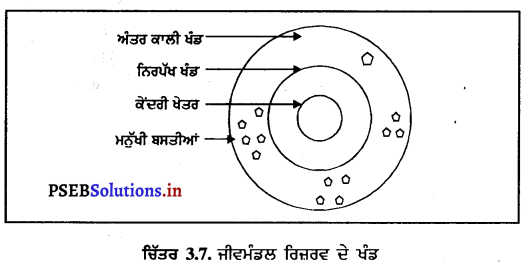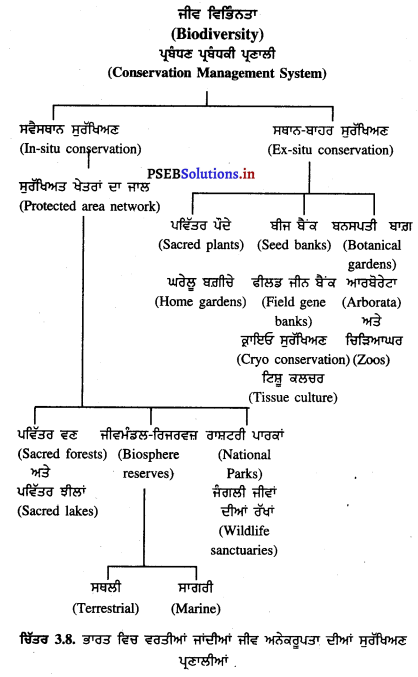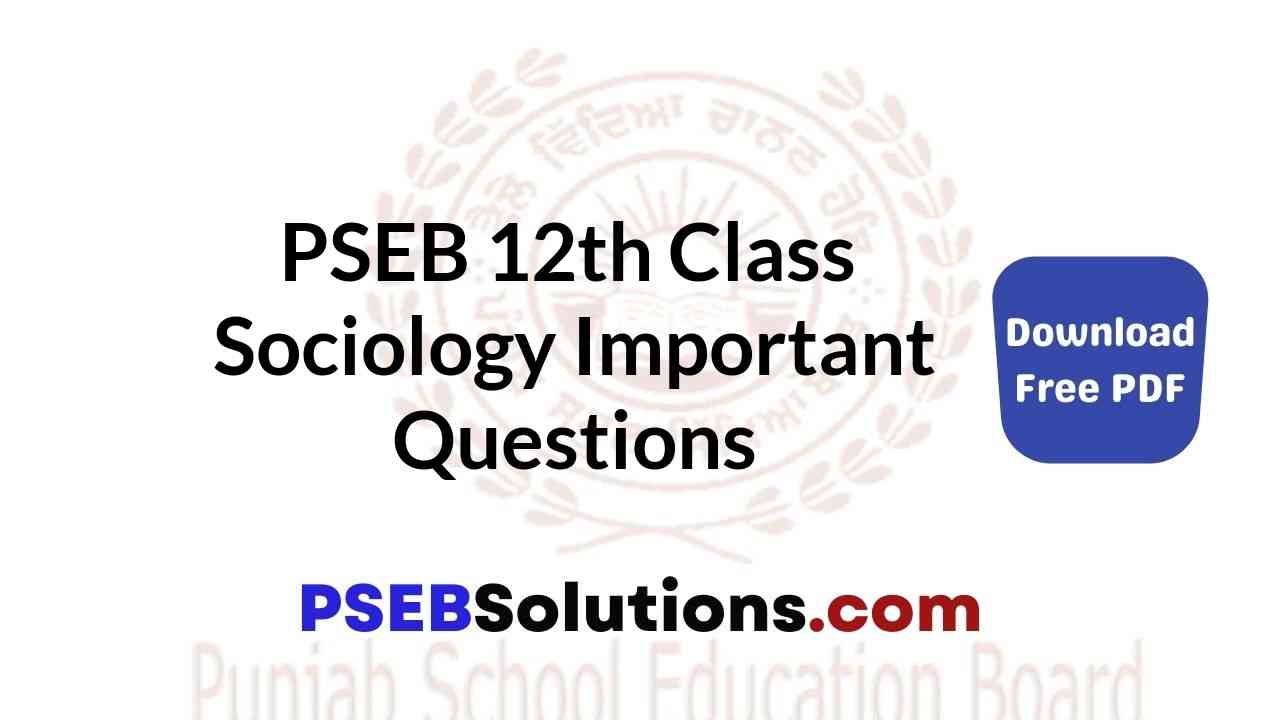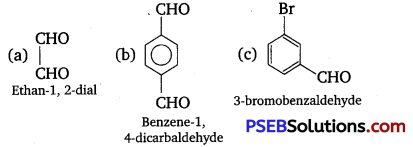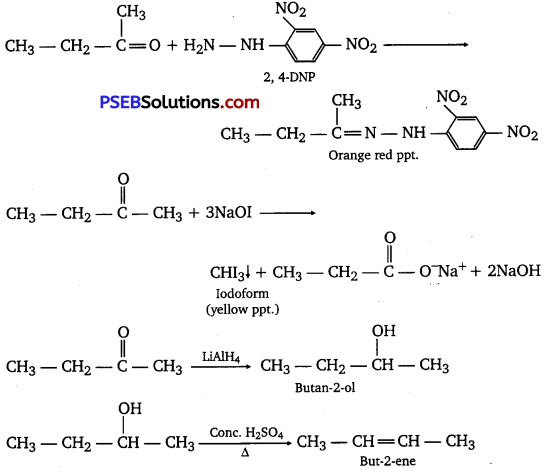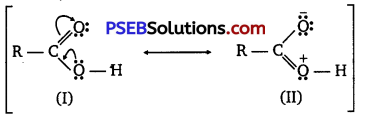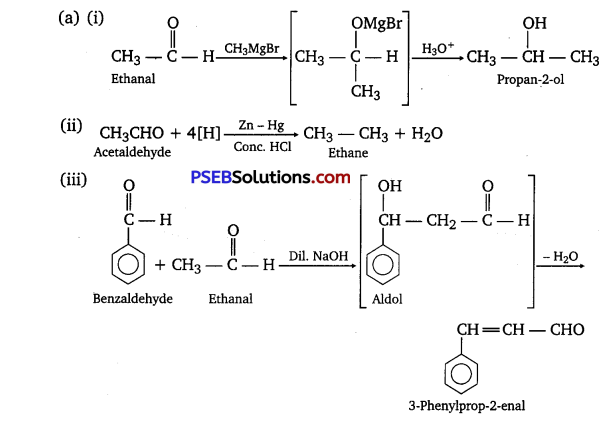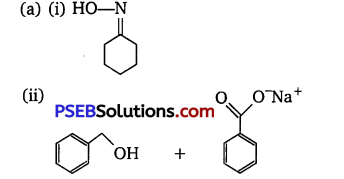Punjab State Board PSEB 12th Class Environmental Education Important Questions Chapter 4 ਵਾਤਾਵਰਣੀ ਪ੍ਰਬੰਧਣ (ਭਾਗ-1) Important Questions and Answers.
PSEB 12th Class Environmental Education Important Questions Chapter 4 ਵਾਤਾਵਰਣੀ ਪ੍ਰਬੰਧਣ (ਭਾਗ-1)
ਬਹੁਤ ਛੋਟੇ ਉੱਤਰਾਂ ਵਾਲੇ ਪ੍ਰਸ਼ਨ (Very Short Answer Type Questions)
ਪ੍ਰਸ਼ਨ 1.
ਵਾਤਾਵਰਣ ਕੀ ਹੈ ?
ਉੱਤਰ-
ਸਾਡੇ ਚਾਰੇ ਪਾਸੇ ਮੌਜੂਦ ਭੌਤਿਕ ਅਤੇ ਜੈਵਿਕ ਘਟਕਾਂ ਦੇ ਕੁੱਲ ਜੋੜ ਨੂੰ ਵਾਤਾਵਰਣ ਆਖਦੇ ਹਨ ।
ਪ੍ਰਸ਼ਨ 2.
ਸਾਫ਼-ਸੁਥਰੇ ਵਾਤਾਵਰਣ (Healthy Environment) ਤੋਂ ਤੁਹਾਡਾ ਕੀ ਭਾਵ ਹੈ ?
ਉੱਤਰ-
ਜਿਸ ਵਾਤਾਵਰਣ ਵਿਚ ਜੀਵਨ ਦੀ ਉਤਮਤਾ ਸਭ ਤੋਂ ਚੰਗੀ ਅਤੇ ਉੱਚੀ ਹੋਵੇ ਅਤੇ ਵਾਤਾਵਰਣ ਦਾ ਵਿਘਟਨ ਨਿਊਨਤਮ ਪੱਧਰ ‘ਤੇ ਹੋਵੇ, ਤਾਂ ਅਜਿਹੇ ਵਾਤਾਵਰਣ ਨੂੰ ਸਾਫ਼-ਸੁਥਰਾਂ ਜਾਂ ਨਰੋਆ ਵਾਤਾਵਰਣ ਆਖਦੇ ਹਨ ।
![]()
ਪ੍ਰਸ਼ਨ 3.
ਵਾਤਾਵਰਣ ਦੇ ਦੋ ਸੰਘਟਕਾਂ ਦੇ ਨਾਮ ਲਿਖੋ ।
ਉੱਤਰ-
ਜੈਵਿਕ ਸੰਘਟਕ ਅਤੇ ਅਜੈਵਿਕ ਸੰਘਟਕ ।
ਪ੍ਰਸ਼ਨ 4.
ਮਨੁੱਖ ਜਾਤੀ ਦੇ ਭਵਿੱਖ ਸੰਬੰਧੀ ਦੋ ਮੁਕਾਬਲੇ ਵਾਲੇ ਦ੍ਰਿਸ਼-ਵੇਰਵਿਆਂ (Scenerio) ਦੀ ਸੂਚੀ ਬਣਾਓ ।
ਉੱਤਰ-
- ਉੱਜਲਾ ਭਵਿੱਖ ।
- ਘਟਦੇ ਹੋਏ ਕੁਦਰਤੀ ਸਰੋਤਾਂ ਦੇ ਨਾਲ-ਨਾਲ ਵਸੋਂ ਵਿਚ ਵਾਧਾ ।
ਪ੍ਰਸ਼ਨ 5.
ਵਾਤਾਵਰਣ ਨੂੰ ਹੈਂਡਲ ਕਰਨ ਅਤੇ ਦੇਖ-ਭਾਲ ਕਰਨ ਲਈ ਵਰਤੇ ਜਾਂਦੇ ਪਦ ਦਾ ਨਾਮ ਦੱਸੋ ।
ਉੱਤਰ-
ਵਾਤਾਵਰਣੀ ਪ੍ਰਬੰਧਣ (Environmental Management) ।
ਪ੍ਰਸ਼ਨ 6.
ਵਾਤਾਵਰਣ ਦੇ ਪੱਖਾਂ ਦਾ ਵਰਣਨ ਕਰੋ ।
ਉੱਤਰ-
ਨੈਤਿਕ ਪੱਖ, ਆਰਥਿਕ ਪੱਖ, ਤਕਨੀਕੀ ਪੱਖ ਅਤੇ ਸਮਾਜਿਕ ਪੱਖ ।
ਪ੍ਰਸ਼ਨ 7.
ਵਾਤਾਵਰਣ ਪ੍ਰਬੰਧਣ ਦੇ ਤਿੰਨ ਪੱਖਾਂ ਦੇ ਨਾਮ ਲਿਖੋ ।
ਉੱਤਰ-
- ਰੋਕਥਾਮ ਅਤੇ ਨਿਯੰਤਰਣ ਪੱਖ
- ਨੀਤੀ ਘੜਨਾ ਅਤੇ
- ਵਾਤਾਵਰਣੀ ਅਨੁਵਣ (Environment Monitoring) ।
ਪ੍ਰਸ਼ਨ 8.
ਵਾਤਾਵਰਣੀ ਨੈਤਿਕਤਾ (Environmental Ethics) ਨੂੰ ਪਰਿਭਾਸ਼ਿਤ ਕਰੋ ।
ਉੱਤਰ-
ਵਾਤਾਵਰਣ ਸਮੇਤ ਸਜੀਵਾਂ ਨਾਲ ਸੰਬੰਧਿਤ ਮਨੁੱਖੀ ਫਰਜ਼ਾਂ ਨੂੰ ਵਾਤਾਵਰਣੀ ਨੈਤਿਕਤਾ ਆਖਦੇ ਹਨ ।
ਪ੍ਰਸ਼ਨ 9.
ਵਿਕਸਿਤ ਹੋਏ ਦੇਸ਼ ਵਿਕਾਸ ਕਰ ਰਹੇ ਦੇਸ਼ਾਂ ਨੂੰ ਕਿਸ ਤਰ੍ਹਾਂ ਨੁਕਸਾਨ ਪਹੁੰਚਾ ਰਹੇ
ਹਨ ?
ਉੱਤਰ-
ਵਿਕਸਿਤ ਹੋਏ ਦੇਸ਼ ਵਾਤਾਵਰਣ ਨੂੰ ਆਪਣੇ ਲਾਲਚ ਅਤੇ ਐਸ਼-ਅਰਾਮ ਦੇ ਸਾਧਨਾਂ ਦੇ ਮਾਰੇ ਅਤੇ ਵਿਕਾਸ ਕਰ ਰਹੇ ਦੇਸ਼ ਲਾਲਚ ਦੇ ਮਾਰੇ ਵਾਤਾਵਰਣ ਅਤੇ ਵਿਕਾਸ ਕਰ ਰਹੇ ਦੇਸ਼ਾਂ ਨੂੰ ਨੁਕਸਾਨ ਪਹੁੰਚਾ ਰਹੇ ਹਨ ।
ਪ੍ਰਸ਼ਨ 10.
ਜੀ. ਐੱਨ. ਪੀ. (G.N.P.) ਕੀ ਹੈ ?
ਜਾਂ
ਜੀ. ਐੱਨ. ਪੀ. (G.N.P.) ਦਾ ਵਿਸਤਾਰ ਰੂਪ ਕੀ ਹੈ ?
ਉੱਤਰ-
ਜੀ ਐੱਨ ਪੀ = ਕੁੱਲ ਰਾਸ਼ਟਰੀ ਉਤਪਾਦ (GNP = Gross National Product)
![]()
ਪ੍ਰਸ਼ਨ 11.
ਜੀ. ਡੀ. ਪੀ. (GD.P.) ਦਾ ਵਿਸਤਾਰ ਰੂਪ ਕੀ ਹੈ ?
ਉੱਤਰ-
ਜੀ. ਡੀ. ਪੀ. = ਗੋਥ ਡੋਮੈਸਟਿਕ (ਘਰੇਲੁ) ਪਾਡਕਟ, (GDP = Gross Domestic Product) ।
ਪ੍ਰਸ਼ਨ 12.
ਵਿਕਸਿਤ ਦੇਸ਼ ਦੀਆਂ ਜਾਂ ਕੁੱਝ ਘਰੇਲੂ ਉਤਪਾਦ ਕਸਵੱਟੀਆਂ (Criteria) ਦੇ ਨਾਮ ਲਿਖੋ ।
ਉੱਤਰ-
ਵਿਕਸਿਤ ਦੇਸ਼ ਦਾ ਜੀ. ਡੀ. ਪੀ. ਅਤੇ ਜੀ. ਐੱਨ. ਪੀ. ਦਾ ਉੱਚਾ ਹੋਣਾ ਉਸ ਦੇਸ਼ ਦੀ ਕਸਵੱਟੀ ਹੁੰਦੀ ਹੈ ।
ਪ੍ਰਸ਼ਨ 13.
ਆਰਥਿਕ ਵਿਕਾਸ ਦੇ ਦੋ ਮਹੱਤਵਪੂਰਨ ਸੂਚਕਾਂ ਦੇ ਨਾਮ ਦੱਸੋ ।
ਉੱਤਰ-
- ਉਦਯੋਗੀਕਰਨ
- ਸ਼ਹਿਰੀਕਰਨ ।
ਪ੍ਰਸ਼ਨ 14
ਨਵਿਆਉਣਯੋਗ ਅਤੇ ਨਾ-ਨਵਿਆਉਣ ਸਰੋਤਾਂ ਦੇ ਸਖਣਿਆਉਣ ਦੇ ਕੀ ਕਾਰਨ ਹਨ ?
ਉੱਤਰ-
ਬਹੁਤ ਜ਼ਿਆਦਾ ਤੇਜ਼ੀ ਨਾਲ ਵਧ ਰਿਹਾ ਉਦਯੋਗੀਕਰਨ ਅਤੇ ਵੱਧ ਰਹੀ ਵਸੋਂ ਦਾ ਭਾਰ ।
ਪ੍ਰਸ਼ਨ 15.
ਡੈਮਾਂ ਦੀ ਕੀ ਉਪਯੋਗਤਾ ਹੈ ?
ਉੱਤਰ-
ਡੈਮਾਂ ਦੀ ਉਸਾਰੀ ਨਾਲ ਜਲ ਸਰੋਤਾਂ ਦੀ ਵਰਤੋਂ ਪਣ ਬਿਜਲੀ ਪੈਦਾ ਕਰਨ, ਸਿੰਜਾਈ ਕਰਨ ਅਤੇ ਪੀਣ ਵਾਲੇ ਪਾਣੀ ਦੀ ਪੂਰਤੀ ਕਰਨ ਦੇ ਮੰਤਵ ਨਾਲ ਕੀਤੀ ਜਾਣੀ ਹੈ ।
ਪ੍ਰਸ਼ਨ 16.
ਸਾਨੂੰ ਓਜ਼ੋਨ ਦੇ ਸਖਣਿਆਉਣ ਨੂੰ ਬਚਾਉਣ ਦੇ ਲਈ ਕਿਸ ਤਕਨਾਲੋਜੀ ਨੂੰ ਅਪਨਾਉਣਾ ਚਾਹੀਦਾ ਹੈ ?
ਉੱਤਰ-
ਗੈਰ-ਕਲੋਰੋਫਲੋਰੋ ਕਾਰਬਨ ਟੈਕਨਾਲੋਜੀ (Non Chlorofluoro Carbon Technology)
![]()
ਪ੍ਰਸ਼ਨ 17.
ਹਰ ਸਾਲ ਕਿੰਨੇ ਨਵੇਂ ਡੈਮ ਤਿਆਰ ਕੀਤੇ ਜਾਂਦੇ ਹਨ ?
ਉੱਤਰ-
ਲਗਪਗ 160 ਤੋਂ ਲੈ ਕੇ 230 ਤੱਕ ।
ਪ੍ਰਸ਼ਨ 18.
ਸਹਿਣ ਸਮਰੱਥਾ (Carrying Capacity) ਨੂੰ ਪਰਿਭਾਸ਼ਿਤ ਕਰੋ ।
ਉੱਤਰ-
ਸਹਿਣ ਸਮਰੱਥਾ-ਕਿਸੇ ਖਾਸ ਸਾਧਨ ਦੁਆਰਾ ਵੱਧ ਤੋਂ ਵੱਧ ਸਜੀਵਾਂ ਨੂੰ ਕਾਇਮ ਰੱਖਣ ਅਤੇ ਸਹਾਰਾ ਦੇਣ ਦੀ ਸਮਰੱਥਾ ਨੂੰ ਝਲਣ ਜਾਂ ਸਹਿਣ ਸਮਰੱਥਾ ਆਖਦੇ ਹਨ ।
ਪ੍ਰਸ਼ਨ 19.
ਵਾਤਾਵਰਣੀ ਪ੍ਰਬੰਧਣ ਕੀ ਹੈ ?
ਉੱਤਰ-
ਵਾਤਾਵਰਣੀ ਪ੍ਰਬੰਧਣ – ਵਾਤਾਵਰਣ ਦੇ ਜੈਵਿਕ ਅਤੇ ਅਜੈਵਿਕ ਸੰਘਟਕਾਂ ਦੇ ਪ੍ਰਬੰਧ ਨੂੰ ਵਾਤਾਵਰਣੀ ਪ੍ਰਬੰਧਣ ਆਖਦੇ ਹਨ ।
ਪ੍ਰਸ਼ਨ 20.
ਵਾਤਾਵਰਣੀ ਨੈਤਿਕਤਾ ਕੀ ਹੈ ?
ਉੱਤਰ-
ਵਾਤਾਵਰਣੀ ਨੈਤਿਕਤਾ (Environmental Ethics) – ਵਾਤਾਵਰਣ ਅਤੇ ਦੂਸਰੇ ਸਜੀਵਾਂ ਵੱਲ ਮਨੁੱਖੀ ਸੰਬੰਧਾਂ ਨੂੰ ਵਾਤਾਵਰਣੀ ਨੈਤਿਕਤਾ ਆਖਦੇ ਹਨ ।
ਪ੍ਰਸ਼ਨ 21.
ਵਾਤਾਵਰਣੀ ਪ੍ਰਬੰਧਣ ਦੇ ਦੋ ਆਰਥਿਕ ਪੱਖਾਂ ਦੇ ਨਾਮ ਦੱਸੋ ।
ਉੱਤਰ-
- ਆਰਥਿਕ ਹਾਨੀ ਨੂੰ ਘਟਾਉਣਾ
- ਵਾਤਾਵਰਣ ਦਾ ਏਕੀਕਰਨ ।
ਪ੍ਰਸ਼ਨ 22.
ਵਾਤਾਵਰਣ ਪ੍ਰਬੰਧਣ ਦੀਆਂ ਦੋ ਨਿਸ਼ਾਨੀਆਂ ਦੇ ਨਾਮ ਦੱਸੋ ।
ਉੱਤਰ-
- ਅਨੇਕਰੂਪਤਾ ਦੀ ਸਾਂਭ-ਸੰਭਾਲ
- ਬੁਨਿਆਦੀ ਲੋੜਾਂ ਦੀ ਪੂਰਤੀ ਕਰਨਾ ।
ਵਾਤਾਵਰਣੀ ਨੈਤਿਕਤਾ ਸਾਫ਼-ਸੁਥਰੇ ਵਾਤਾਵਰਣ ਨੂੰ ਯਕੀਨੀ ਬਣਾਉਂਦੀ ਹੈ ਤਾਂ ਜੋ ਕੁਦਰਤ ਵਿਚ ਸਾਰੀਆਂ ਜਾਤੀਆਂ ਜੀਵਿਤ ਰਹਿ ਸਕਣ ।
ਪ੍ਰਸ਼ਨ 23.
CFCs ਦਾ ਵਿਸਤਾਰ ਕਰੋ ।
ਉੱਤਰ-
CFCs = ਕਲੋਰੋ ਫਲੋਰੋ ਕਾਰਬਨ (Chloroflowro carbon).
![]()
ਪ੍ਰਸ਼ਨ 24.
ਭਾਖੜਾ ਨੰਗਲ ਡੈਮ ਨੂੰ ਕਿਸ ਨੇ ਭਾਰਤ ਦੇ ਮੰਦਰ ਦਾ ਨਾਂ ਦਿੱਤਾ ਸੀ ?
ਉੱਤਰ-
ਪੰਡਿਤ ਜਵਾਹਰ ਲਾਲ ਨਹਿਰੁ ।
ਛੋਟੇ ਉੱਤਰਾਂ ਵਾਲੇ ਪ੍ਰਸ਼ਨ (Short Answer Type Questions)
ਪ੍ਰਸ਼ਨ 1.
ਵਾਤਾਵਰਣੀ ਪ੍ਰਬੰਧਣ (Environmental Management) ਕੀ ਹੈ ?
ਉੱਤਰ-
ਵਾਤਾਵਰਣੀ ਪਬੰਧਣ (Environmental Management) – ਵਾਤਾਵਰਣ ਸ਼ਬਦ ਫਰਾਂਸੀਸੀ ਭਾਸ਼ਾ ਐਨਮਾਇਰੋਨਿਰ (Environier) ਤੋਂ ਲਿਆ ਗਿਆ ਸ਼ਬਦ ਹੈ ਜਿਸਦਾ ਅਰਥ ਹੈ ਕੋਈ ਵਸਤੂ ਜੋ ਘੇਰੇ (Something that surrounds) ਵਾਤਾਵਰਣ ਨੂੰ ਆਲਾ ਦੁਆਲਾ ਜਾਂ ਚੌਗਿਰਦਾ ਵੀ ਕਹਿੰਦੇ ਹਨ । ਵਾਤਾਵਰਣ ਦੇ ਬਚਾਓ, ਸੁਰੱਖਿਅਣ ਅਤੇ ਦੇਖਭਾਲ ਦੇ ਵਾਸਤੇ ਸਰਕਾਰ ਅਤੇ ਵਿਅਕਤੀ ਜ਼ਿੰਮੇਵਾਰ ਹਨ । ਵਾਤਾਵਰਣ ਦੇ ਪ੍ਰਬੰਧਣ ਸੰਬੰਧੀ ਯੋਜਨਾਵਾਂ ਤਿਆਰ ਕਰਨੀਆਂ ਅਤੇ ਲਾਗੂ ਕਰਨ ਸੰਬੰਧੀ ਕੀਤੀਆਂ ਕਾਰਵਾਈਆਂ ਦੇ ਜ਼ਿੰਮੇਵਾਰੀ ਸੰਗਠਨਾਂ, ਸਰਕਾਰ ਅਤੇ ਵਿਅਕਤੀਆਂ ਦੀ ਬਣਦੀ ਹੈ | ਅਜਿਹਾ ਕਰਨ ਦੇ ਨਾਲ ਮਨੁੱਖੀ ਵਾਤਾਵਰਣ (Human Environment) ਦੀ ਉੱਤਮਤਾ ਵਧਦੀ ਹੈ । ਟਿਕਾਊ ਵਿਕਾਸ/ ਕਾਇਮ ਰੱਖਣਯੋਗ ਵਿਕਾਸ ਦੇ ਜਾਰੀ ਰਹਿਣ ਦੇ ਵਾਸਤੇ ਵਾਤਾਵਰਣ ਦੀ ਸੁਰੱਖਿਆ ਅਤੇ ਸੁਧਾਰ ਕਰਨ ਦੇ ਵਾਸਤੇ ਵੱਖ-ਵੱਖ ਤਰ੍ਹਾਂ ਦੇ ਉਪਾਵਾਂ ਨੂੰ ਲਾਮਬੰਦ ਕਰਨਾ ਜ਼ਰੂਰੀ ਹੁੰਦਾ ਹੈ ।
ਵਾਤਾਵਰਣ ਅਜੈਵਿਕ ਜਾਂ ਭੌਤਿਕ (Abiotic or Physical) ਅਤੇ ਜੈਵਿਕ (Biotic) ਆਲੇ-ਦੁਆਲੇ ਵਲ ਸੰਕੇਤ ਕਰਦਾ ਹੈ । ਵਾਤਾਵਰਣ ਦੇ ਅਜੈਵਿਕ ਸੰਘਟਕ ਜਿਵੇਂ ਕਿ ਹਵਾ, ਪਾਣੀ ਅਤੇ ਮਿੱਟੀ ਨਾ ਕੇਵਲ ਆਪਿਸ ਵਿਚ ਅੰਤਰ ਕਿਰਿਆਵਾਂ ਹੀ ਕਰਦੇ ਹਨ ਸਗੋਂ ਇਨ੍ਹਾਂ ਦਾ ਸੰਬੰਧ ਜੈਵਿਕ ਘਟਕਾਂ ਜਿਵੇਂ ਕਿ ਪੌਦੇ ਅਤੇ ਪਾਣੀਆਂ ਨਾਲ ਵੀ ਹੈ । ਵਾਤਾਵਰਣ ਦੇ ਇਹ ਘਟਕ ਆਪਸੀ ਨਿਕਟ ਵਰਤੀ ਸੰਬੰਧ ਵੀ ਦਰਸਾਉਂਦੇ ਹਨ ।
ਹਰੇ ਪੌਦੇ ਉਤਪਾਦਕ (Producers) ਹਨ ਜਦਕਿ ਪ੍ਰਾਣੀ ਉਪਭੋਗਤਾ ਹਨ । ਸੂਖ਼ਮ ਜੀਵ ਨਿਖੇੜਕਾਂ ਵਜੋਂ ਕਿਰਿਆਵਾਂ ਕਰਦੇ ਹਨ ।
ਪ੍ਰਸ਼ਨ 2.
ਵਾਤਾਵਰਣੀ ਪ੍ਰਬੰਧਣ ਕਿਉਂ ਜ਼ਰੂਰੀ ਹੈ ?
ਉੱਤਰ-
ਵਾਤਾਵਰਣ ਦੇ ਜੈਵਿਕ (Biotic) ਅਤੇ ਅਜੈਵਿਕ (Abiotic) ਅੰਸ਼ ਆਪਸੀ ਅੰਤਰਕ੍ਰਿਆਵਾਂ ਅਤੇ ਆਪਸੀ ਨਿਰਭਰਤਾ ਨੂੰ ਪਦਾਰਥ ਚੱਕਰਣ (Material Cycling), ਭੋਜਨ ਲੜੀਆਂ, ਭੋਜਨ ਜਾਲ ਅਤੇ ਊਰਜਾ ਵਹਿਣ ਆਦਿ ਦੁਆਰਾ ਦਰਸਾਉਂਦੇ ਹਨ । ਇਸ ਲਈ ਕਿਸੇ ਵੀ ਇਕ ਪੜਾਅ ਦੇ ਅਪਘਟਣ ਕਾਰਨ ਪਰਿਸਥਿਤਿਕੀ ਸੰਕਟ ਪੈਦਾ ਹੋ ਜਾਣ ਦੇ ਨਤੀਜੇ ਵਜੋਂ ਜੀਵਨ ਦੀ ਕਾਇਮੀ ਅਤੇ ਉੱਤਰਜੀਵਤਾ ਲਈ ਖ਼ਤਰਾ ਬਣ ਸਕਦਾ ਹੈ ।
ਪ੍ਰਸ਼ਨ 3.
ਵਾਤਾਵਰਣੀ ਨੈਤਿਕਤਾ (Environmental Ethics) ਕੀ ਹੈ ? ਉਨ੍ਹਾਂ ਵਿੱਚੋਂ ਕੁੱਝ ਨੂੰ ਸੂਚੀਬੱਧ ਕਰੋ ।
ਜਾਂ
ਵਾਤਾਵਰਣੀ ਪ੍ਰਬੰਧ ਦੇ ਤਿੰਨ ਨੈਤਿਕ ਪੱਖ ਲਿਖੋ ।
ਉੱਤਰ-
ਵਾਤਾਵਰਣ ਵਲ ਮਾਨਵਤਾ ਦੀਆਂ ਜ਼ਿੰਮੇਵਾਰੀਆਂ ਨੂੰ ਵਾਤਾਵਰਣੀ ਨੈਤਿਕਤਾ ਜਾਂ ਪ੍ਰਿਥਵੀ ਨੈਤਿਕਤਾ (Earth Ethics) ਕਹਿੰਦੇ ਹਨ । ਇਨ੍ਹਾਂ ਵਿਚ ਸ਼ਾਮਿਲ ਹਨ-
- ਕੁਦਰਤੀ ਸਾਧਨਾਂ ਨੂੰ ਜਾਇਆ ਜਾਣ ਤੋਂ ਬਚਾਇਆ ਜਾਵੇ ।
- ਦੁਸਰਿਆਂ ਨੂੰ ਅਲੋਪ ਕਰਨ ਦਾ ਕਿਸੇ ਨੂੰ ਕੋਈ ਹੱਕ ਨਹੀਂ ।
- ਧਰਤੀ ਮਾਂ (Mother. Earth) ਨਾਲ ਪਿਆਰ ਅਤੇ ਇਸਦੀ ਇੱਜ਼ਤ ਕਰਨੀ ।
- ਮਨੁੱਖ ਕੁਦਰਤ ਦਾ ਸਾਥੀ ਬਣ ਕੇ ਰਹੇ ਨਾ ਕਿ ਇਸ ਦਾ ਮਾਲਕ ।
- ਵਾਤਾਵਰਣੀ ਨੈਤਿਕਤਾ ਸਾਫ਼-ਸੁਥਰੇ ਵਾਤਾਵਰਣ ਨੂੰ ਯਕੀਨੀ ਬਣਾਏਗੀ ਤਾਂ ਜੋ ਕੁਦਰਤ ਵਿਚ ਸਾਰੀਆਂ ਜਾਤੀਆਂ ਜੀਵਿਤ ਰਹਿ ਸਕਣ।
ਪ੍ਰਸ਼ਨ 4.
ਆਰਥਿਕ ਵਿਕਾਸ ਦੇ ਲਈ ਵਾਤਾਵਰਣ ਦੇ ਕਾਰਜਾਂ ਦੀ ਸੂਚੀ ਦਿਓ ।
ਜਾਂ
ਵਾਤਾਵਰਣੀ ਪ੍ਰਬੰਧ ਦੇ ਚਾਰ ਆਰਥਿਕ ਪੱਖ ਦੱਸੋ । (P.S.E.B. 2009, 10, 17)
ਉੱਤਰ-
- ਵਾਤਾਵਰਣ ਤੋਂ ਪ੍ਰਾਪਤ ਕੱਚੇ ਮਾਲ (Raw Material) ਨੂੰ ਵਰਤਣਯੋਗ ਪਦਾਰਥਾਂ ਵਿਚ · ਬਦਲਿਆ ਜਾਂਦਾ ਹੈ ।
- ਵਾਤਾਵਰਣ ਤੋਂ ਪਾਣੀ, ਆਕਸੀਜਨ ਆਦਿ ਵਰਗੀਆਂ ਜੀਵਨ-ਸਹਾਇਕ ਸੇਵਾਵਾਂ ਦੇ ਇਲਾਵਾ ਮਨ ਪਰਚਾਵੇ ਦੇ ਸਾਧਨ ਵੀ ਉਪਲੱਬਧ ਹੁੰਦੇ ਹਨ ।
- ਵਾਤਾਵਰਣ ਫੋਕਟ ਪਦਾਰਥਾਂ ਦੇ ਸ਼ਾਹੀ ਵਜੋਂ (As a Sink) ਵੀ ਕਾਰਜ ਕਰਦਾ ਹੈ ।
ਪ੍ਰਸ਼ਨ 5.
ਜੀ. ਡੀ. ਪੀ. (G.D.P.) ਕੀ ਹੈ ? ਵਿਕਾਸ ਦੇ ਤੱਤਾਂ ਨੂੰ ਸੂਚੀਬੱਧ ਕਰੋ ।
ਉੱਤਰ-
ਜੀ. ਡੀ. ਪੀ. (G.D.P.) – Growth Domestic Product ਵਾਸੀਆਂ ਅਤੇ ਪਰਵਾਸੀਆਂ (Non-Residents) ਦੋਵਾਂ ਦੀ ਆਰਥਿਕਤਾ ਦੁਆਰਾ ਵਰਤੇ ਜਾਣ ਵਾਲੇ ਸਾਮਾਨ (Goods) ਅਤੇ ਸੇਵਾਵਾਂ ਦਾ ਉਤਪਾਦਨ ਬਗੈਰ ਕਿਸੇ ਘਰੇਲੂ ਜਾਂ ਬਾਹਰਲੇ ਕਲੇਸ਼ ਦੇ ਪ੍ਰਾਪਤ ਹੋਣ ਵਾਲੇ ਪਦਾਰਥਾਂ ਨੂੰ ਜੀ.ਡੀ.ਪੀ. ਆਖਦੇ ਹਨ ।
ਵਿਕਾਸ ਨੂੰ ਸੰਮਲਿਤ ਕਰਨ ਵਾਲੇ ਤੱਤ (Elements Which include Development)
- ਜੀਅ ਪ੍ਰਤੀ ਅਸਲ ਆਮਦਨ (Real Income) ਵਿਚ ਵਾਧਾ ।
- ਤਸੱਲੀਬਖ਼ਸ਼ ਜੀਵਨ ਨਿਰਬਾਹ ਲਈ ਮੌਕੇ ।
- ਸਿਹਤ ਅਤੇ ਪੌਸ਼ਟਿਕ ਆਹਾਰ ਦੀ ਪੱਧਰ ਵਿਚ ਸੁਧਾਰ ।
- ਸਿੱਖਿਆ ਸੁਧਾਰ ।
- ਸਾਧਨਾਂ ਦੇ ਖੇਤਰ ।
- ਆਮਦਨ ਦੀ ਸੁਚੱਜੀ ਵੰਡ (Fair Distribution)
- ਬੁਨਿਆਦੀ ਮਨੁੱਖੀ ਅਧਿਕਾਰਾਂ ਦੀ ਯਕੀਨਹਾਨੀ ।
- ਪ੍ਰਾਕ੍ਰਿਤੀ ਅਤੇ ਸਾਧਨਾਂ ਦਾ ਸੁਰੱਖਿਅਣ ।
![]()
ਪ੍ਰਸ਼ਨ 6.
ਟੈਕਨੋਸਫੀਅਰ (Technosphere) ਕੀ ਹੈ ? ਉਦਾਹਰਣ ਦੇ ਕੇ ਸਪੱਸ਼ਟ ਕਰੋ ।
ਉੱਤਰ-
ਟੈਕਨੋਸਫੀਅਰ ਜਾਂ ਟੈਕਨੋਮੰਡਲ (Technosphere) – ਮਨੁੱਖੀ ਗਤੀਵਿਧੀਆਂ ਦੁਆਰਾ ਜੀਵ ਮੰਡਲ ਦਾ ਵੱਖ-ਵੱਖ ਹਿੱਸਿਆਂ/ਸੰਗਠਨਾਂ ਵਿਚ ਕੀਤੇ ਗਏ ਸੁਰੱਖਿਅਣ ਨੂੰ ਟੈਕਨੋਸਫੀਅਰ ਜਾਂ ਟੈਕਨੋਮੰਡਲ ਕਹਿੰਦੇ ਹਨ ।
ਉਦਾਹਰਣ- ਪਿੰਡਾਂ ਦੇ ਛੱਪੜ, ਜਿਨ੍ਹਾਂ ਦੀ ਵਰਤੋਂ ਮੱਛੀਆਂ ਪਾਲਣ ਜਾਂ ਇਸ ਦੇ ਪਾਣੀ ਦੀ ਭਿੰਨ-ਭਿੰਨ ਕੰਮਾਂ ਲਈ ਵਰਤੋਂ ਪਿੰਡ ਦੀ ਆਰਥਿਕਤਾ ਉੱਪਰ ਅਸਰ ਪਾਉਂਦੀ ਹੈ । ਇਸ ਦੇ ਨਾਲ ਹੀ ਇਹ ਛੱਪੜ ਹਾਨੀਕਾਰਕ ਜੀਵਾਂ ਦੇ ਨਾਸ਼ਕਾਂ, ਫਰਟੀਲਾਈਜ਼ਰ ਅਤੇ ਦੂਸਰੇ ਹੋਰ ਫੋਕਟ ਪਦਾਰਥਾਂ ਦੇ ਗਾਹੀ ਵਜੋਂ ਕੰਮ ਕਰਦਾ ਹੈ । ਇਸ ਦਾ ਸਿੱਟਾ ਨਵਾਂ ਸੈਂਟ-ਅਪ (Set up) ਦੀ ਸਥਾਪਨਾ ਕਰਨਾ ਨਿਕਲਿਆ ਹੈ । ਇਸ ਤਰ੍ਹਾਂ ਸਥਾਪਿਤ ਹੋਣ ਵਾਲੇ ਸੈਂਟ-ਅਪ ਦਾ ਨਤੀਜਾ ਅਭਾਵੀ ਨਕਾਰਾਤਮਕ (Negative) ਨਿਕਲਿਆ ਹੈ ਜਿਹੜਾ ਕਿ ਧਰਤੀ ਉੱਤੇ ਮੌਜੂਦ ਜੀਵਨ ਸਹਾਇਕ ਪ੍ਰਣਾਲੀਆਂ ਦੇ ਲਈ ਭੈੜਾ ਹੈ ।
ਪ੍ਰਸ਼ਨ 7.
ਡੈਮ ਕਿਉਂ ਉਸਾਰੇ ਜਾਂਦੇ ਹਨ ? ਇਨ੍ਹਾਂ ਦੇ ਨਕਾਰਾਤਮਕ ਪ੍ਰਭਾਵਾਂ ਦੀ ਸੂਚੀ ਬਣਾਓ ।
ਉੱਤਰ-
ਡੈਮਾਂ ਦੀ ਉਸਾਰੀ ਹੇਠ ਲਿਖੇ ਪ੍ਰਯੋਜਨਾਂ ਲਈ ਕੀਤੀ ਜਾਂਦੀ ਹੈ ।
- ਸਿੰਜਾਈ,
- ਬਿਜਲੀ ਪਣ ਬਿਜਲੀ ਪੈਦਾ ਕਰਨ ਲਈ,
- ਜਲ-ਪਾਰਕ (WaterPark)
- ਪੀਣ ਵਾਲਾ ਪਾਣੀ ਮੁਹੱਈਆ ਕਰਵਾਉਣ ਦੇ ਲਈ ।
ਡੈਮਾਂ ਦੇ ਨਕਾਰਾਤਮਕ (Negative) ਪ੍ਰਭਾਵ (Negative Impact of Dams)
- ਵਣ ਭੂਮੀ ਦਾ ਗੁੰਮ ਹੋਣਾ ।
- ਜੀਵ ਵਿਭਿੰਨਤਾ ਦੀ ਗੁੰਮਸ਼ੁਦਗੀ
- ਵੱਡੀ ਸੰਖਿਆ ਵਿਚ ਆਬਾਦੀ ਦਾ ਵਿਸਥਾਪਨ
- ਡੈਮ ਨੇੜਲੇ ਖੇਤਰ ਵਿਚ ਭੂਚਾਲਾਂ ਦਾ ਖ਼ਤਰਾ ਵੱਧ ਜਾਣਾ ।
ਪ੍ਰਸ਼ਨ 8.
ਸਹਿਣਯੋਗ ਸਮਰੱਥਾ (Carrying Capacity) ਕੀ ਹੈ ?
ਉੱਤਰ-
ਕਿਸੇ ਪਰਿਸਥਿਤਿਕ ਪ੍ਰਣਾਲੀ (Eco System) ਦੁਆਰਾ ਵਸੋਂ ਦੇ ਆਕਾਰ ਦਿੱਤੇ ਗਏ ਸਮਰਥਨ ਨੂੰ ਸਹਿਣਯੋਗ ਸਮਰੱਥਾ ਆਖਦੇ ਹਨ ਅਤੇ ਇਹ ਨਿਰਭਰ ਕਰਦਾ ਹੈ-
- ਪਰਿਸਥਿਤਿਕ ਪ੍ਰਣਾਲੀ ਵਿਚ ਉਪਲੱਬਧ ਸਰੋਤਾਂ ਦੀ ਮਾਤਰਾ
- ਵਸੋਂ ਦਾ ਆਕਾਰ ।
- ਹਰੇਕ ਵਿਅਕਤੀ ਦੁਆਰਾ ਵਰਤੇ ਜਾਂਦੇ ਸਾਧਨਾਂ ਦੀ ਮਾਤਰਾ ।
ਪ੍ਰਸ਼ਨ 9.
ਮਨੁੱਖ ਦੁਆਰਾ ਰਚਿਤ ਜਗ ਵਿਚਾਰ (World View) ਅਤੇ ਈਕੋ-ਕੇਂਦਰਿਤ ਜਗ ਵਿਚਾਰ (Eco-centric world view) ਵਿਚ ਅੰਤਰ ਦੱਸੋ । ਉੱਤਰ-
| ਲੱਛਣ (Characteristics) | ਮਨੁੱਖ ਦੁਆਰਾ ਰਚਿਤ ਵਿਚਾਰ (Anthropogenic View) | ਈਕੋ-ਕੇਂਦਰਿਤ ਵਿਚਾਰ (Eco-Centric View) |
| 1. ਪਰਿਭਾਸ਼ਾ (Definition) | ਮਨੁੱਖ ਜਾਤੀ ਦੀ ਸਫਲਤਾ ਅਤੇ ਨਰੋਈ ਆਰਥਿਕਤਾ ਕੁਦਰਤੀ ਸਾਧਨਾਂ ਦੀ ਸ਼ੋਸ਼ਣ ਦੀ ਡਿਗਰੀ ਉੱਤੇ ਨਿਰਭਰ ਕਰਦੀ ਹੈ । | ਮਨੁੱਖ ਜਾਤੀ ਦੀ ਸਫਲਤਾ ਅਤੇ ਆਰਥਿਕਤਾ ਕੁਦਰਤੀ ਸਾਧਨਾਂ ਦੇ ਨਿਆਂ-ਪੂਰਵਕ ਵਰਤੋਂ ਉੱਪਰ ਨਿਰਭਰ ਕਰਦੀ ਹੈ । |
| 2. ਕੁਦਰਤੀ ਸਾਧਨਾਂ ਦੀ ਅਵਸਥਾ (Status of Natural Resources) | ਪ੍ਰਿਥਵੀ, ਜਿੱਥੋਂ ਸਾਧਨਾਂ ਦੀ ਅਸੀਮਿਤ ਪੂਰਤੀ ਹੁੰਦੀ ਹੈ । | ਪ੍ਰਿਥਵੀ, ਜਿੱਥੋਂ ਕੁਦਰਤੀ ਸਾਧਨਾਂ ਦੀ ਸੀਮਿਤ ਪੂਰਤੀ ਹੁੰਦੀ ਹੈ । |
| 3. ਸਭ ਤੋਂ ਮਹੱਤਵਪੂਰਨ ਅੰਸ਼ (Most Important Component) | ਮਨੁੱਖ ਜਾਤੀ | ਕਿਰਤੀ (Nature) |
| 4. ਵਾਤਾਵਰਣ ਦੀ ਅੰਤਮ ਅਵਸਥਾ (Fate of Environment) | ਵਾਤਾਵਰਣ ਦਾ ਪਤਨ | ਨਰੋਆ ਵਾਤਾਵਰਣ |
![]()
ਪ੍ਰਸ਼ਨ 10.
ਆਰਥਿਕ ਪੱਖ ਤੋਂ ਵਾਤਾਵਰਣੀ ਪ੍ਰਬੰਧਣ ਦੇ ਟੀਚਿਆਂ ਦੀ ਸੂਚੀ ਬਣਾਓ ।
ਜਾਂ
ਵਾਤਾਵਰਣੀ ਪ੍ਰਬੰਧਨ ਦੇ ਤਿੰਨ ਆਰਥਿਕ ਪੱਖ ਲਿਖੋ ।
ਉੱਤਰ-
- ਜੀਵ ਅਨੇਕਰੂਪਤਾ ਦਾ ਸੁਰੱਖਿਅਤ
- ਬੁਨਿਆਦੀ ਲੋੜਾਂ ਨੂੰ ਪੂਰਿਆਂ ਕਰਨਾ
- ਨਿਆਇ ਸੰਗਤੀ (Equity)
- ਮੌਕੇ ਦਾ ਫਾਇਦਾ ਉਠਾਉਣਾ ਅਥਵਾ ਮੌਕੇ ਤਕ ਪਹੁੰਚ ।
- ਰੋਜ਼ਗਾਰ
- ਟਿਕਾਊ ਵਿਕਾਸ
- ਇਸਤਰੀ ਸ਼ਕਤੀ
- ਕੁਦਰਤੀ ਸਾਧਨਾਂ ਦਾ ਸੁਰੱਖਿਅਣ ।
ਪ੍ਰਸ਼ਨ 11.
ਵਾਤਾਵਰਣ ਪ੍ਰਬੰਧ ਦੇ ਤਿੰਨ ਤਕਨੀਕੀ ਪੱਖ ਲਿਖੋ ।
ਉੱਤਰ-
ਵਾਤਾਵਰਣ ਪ੍ਰਬੰਧ ਦੇ ਤਿੰਨ ਤਕਨੀਕੀ ਪੱਖ-
- ਪ੍ਰਦੂਸ਼ਣ ‘ਤੇ ਕਾਬੂ ਪਾਉਣ ਦੇ ਲਈ ਲੈਡ ਰਹਿਤ ਪੈਟਰੋਲ ਅਤੇ ਨਿਪੀੜਤ ਕੁਦਰਤੀ ਗੈਸ ਦੀ ਵਰਤੋਂ ਕਰਨਾ ।
- ਪ੍ਰਦੂਸ਼ਣ ਪੈਦਾ ਕਰਨ ਵਾਲੇ ਨਿਲੰਬਿਤ ਕਣਾਂ ਨੂੰ ਹਟਾਉਣ ਦੇ ਲਈ ਇਲੈੱਕਟ੍ਰੋਸਟੈਟਿਕ ਅਵਖੇਪਕਾਂ (Electrostatic precipators) ਅਤੇ ਮਾਜਿਆਂ (scrubbers) ਦੀ ਵਰਤੋਂ ਕਰਨਾ ।
- ਹਾਨੀਕਾਰਕ ਗੈਸਾਂ ਜਿਵੇਂ ਕਿ SO2, CO2 ਅਤੇ NO2, ਆਦਿ ਨੂੰ ਗਿੱਲੇ ਮਾਜਿਆਂ ਦੁਆਰਾ ਦੂਰ ਕਰਨਾ ।
- ਉਦਯੋਗਾਂ ਦੇ ਵਹਿਣਾਂ ਨੂੰ ਨਿਰੂਪਣ ਕਰਨ ਵਾਲੇ ਪਲਾਟਾਂ (Efficient treatment plants) ਦੀ ਸਹਾਇਤਾ ਨਾਲ ਸ਼ੁੱਧ ਕਰਨਾ ।
ਵੱਡੇ ਉੱਤਰਾਂ ਵਾਲੇ ਪ੍ਰਸ਼ਨ (Long Answer Type Question)
ਪ੍ਰਸ਼ਨ 1.
ਵਾਤਾਵਰਣੀ ਸਾਂਭ-ਸੰਭਾਲ ਦੀ ਜ਼ਰੂਰਤ ਦੀ ਵਿਆਖਿਆ ਕਰੋ ।
ਜਾਂ
ਵਾਤਾਵਰਣ ਪ੍ਰਬੰਧਣ ਕਿਉਂ ਜ਼ਰੂਰੀ ਹੈ ?
ਉੱਤਰ-
ਵਾਤਾਵਰਣੀ ਪ੍ਰਬੰਧਣ ਦੀ ਜ਼ਰੂਰਤ (Need of Environmental Preservation) – ਭੌਤਿਕ ਜਾਂ ਨਿਰਜੀਵ (Non Living) ਤੇ ਜੀਵਿਤ (Living) ਜੀਵ, ਵਾਤਾਵਰਣ ਦੇ ਦੋ ਮੁੱਖ ਸੰਘਟਕ ਹਨ । ਜੀਵਿਤ ਘਟਕਾਂ ਵਿਚ ਪੌਦੇ (ਉਤਪਾਦਕ), ਪ੍ਰਾਣੀ (ਉਪਭੋਗਤਾ) ਅਤੇ ਸੂਖਮ ਜੀਵ (ਨਿਖੇੜਕ) ਸ਼ਾਮਿਲ ਹਨ ਅਤੇ ਇਹ ਸੰਘਟਕ ਆਪਸੀ ਅੰਤਰ-ਕ੍ਰਿਆਵਾਂ, ਭੋਜਨ ਲੜੀਆਂ, ਭੋਜਨ ਜਾਲ, ਮਾਦੇ ਦੇ ਪੁਨਰ-ਚੱਕਰਣ ਅਤੇ ਊਰਜਾ ਸੰਚਾਰ ਦੁਆਰਾ ਦਰਸਾਉਂਦੇ ਹਨ ਅਤੇ ਇਹ ਸਾਰੇ ਕੰਮ ਕੁਦਰਤ ਵਿਚ ਸੰਤੁਲਨ ਦੇ ਕਾਇਮ ਰਹਿਣ ਦੇ ਵਾਸਤੇ ਬਹੁਤ ਜ਼ਰੂਰੀ ਹਨ ।
ਨਿਰਜੀਵ ਸੰਘਟਕਾਂ ਵਿਚ ਪਾਣੀ, ਹਵਾ ਦੇ ਨਾਲ ਵਾਯੂ ਮੰਡਲੀ ਕਾਰਕ ਜ਼ਮੀਨ/ਭੁਮੀ ਨਾਲ ਸੰਬੰਧਿਤ ਕਾਰਕ (Edaphic Factors) ਵੀ ਸ਼ਾਮਲ ਹਨ ।
ਕੁਦਰਤ (Nature) ਵਿਚ ਨਿਰਜੀਵ ਅਤੇ ਜੀਵਿਤ ਘਟਕ ਆਪਸ ਵਿਚ ਅੰਤਰ-ਕ੍ਰਿਆਵਾਂ ਅਤੇ ਆਪਸੀ ਨਿਰਭਰਤਾ ਵੀ ਦਰਸਾਉਂਦੇ ਹਨ ਅਤੇ ਇਨ੍ਹਾਂ ਵਿੱਚੋਂ ਕਿਸੇ ਵੀ ਸੰਘਟਕ ਜਾਂ ਉਪਸੰਘਟਕ (Sub-Component) ਵਿਚ ਆਈ ਤਬਦੀਲੀ ਦੇ ਕਾਰਨ ਪਰਿਸਥਿਤੀ ਦੇ ਸੰਤੁਲਨ ਹੋਮੀਓਸਟੈਸਿਸ (Homeostasis) ਵਿੱਚ ਗੜਬੜੀ ਪੈਦਾ ਹੋ ਸਕਦੀ ਹੈ, ਜਿਸ ਦੇ ਫਲਸਰੂਪ ਪ੍ਰਿਥਵੀ ਉੱਤੇ ਜੀਵਨ ਦੀ ਉੱਤਰਜੀਵਤਾ ਅਤੇ ਕਾਇਮ ਰਹਿਣ ਵਿਚ ਮੁਸ਼ਕਿਲਾਂ ਉਤਪੰਨ ਹੋ ਸਕਦੀਆਂ ਹਨ । ਇਸ ਕਾਰਨ ਜ਼ਮੀਨ ਉੱਤੇ ਜੀਵਨ ਦੇ ਕਾਇਮ ਰਹਿਣ ਦੇ ਵਾਸਤੇ ਸ਼ੁੱਧ ਵਾਤਾਵਰਣ ਦਾ ਹੋਣਾ ਬਹੁਤ ਜ਼ਰੂਰੀ ਹੈ ਕਿਉਂਕਿ ਨਰੋਆ ਵਾਤਾਵਰਣ ਹੀ ਭੋਜਨ, ਉਰਜਾ, ਪਾਣੀ ਅਤੇ ਹਵਾ ਵਰਗੀਆਂ ਮੁੱਢਲੀਆਂ ਜ਼ਰੂਰਤਾਂ ਪੂਰੀਆਂ ਕਰ ਸਕਦਾ ਹੈ ।

